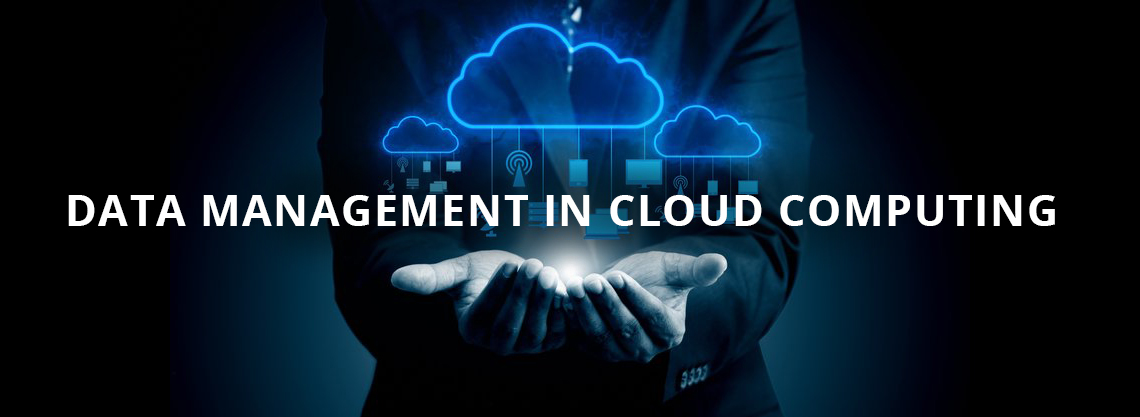IT infrastructure is becoming increasingly complex and enterprises should look out for scalable data management solutions in order to stay afloat. Eventually, data management in cloud computing has become the go-to solution for many of them. Companies are extensively adopting the cloud for it offers cost savings, data availability, flexibility, scalability, and more. However, if you want to leverage the fullest potential of your infrastructure and have a possibility to work both in the cloud and on-prem storage transitioning easily between the two, plan ahead for your data management needs and take a step-by-step approach to meet them.
What is cloud data management?
Data is born around us to evolve every second. This process promises the ability to return anywhere, anytime but the information must also be protected properly with the help of the right data management solution. Some people may experience difficulties in deciding how to start working in the cloud or fail to recognize those promised benefits while on their way. Although the cloud does not come with an instruction manual, it can work for you and your business, anyway. All you need is to have your data managed well.
Businesses used to have centralized on-premise data warehouses where information was safe. Yet, as time went by, it became harder to maintain them; highly skilled manpower and greater maintenance fees are needed now. So, now, in our cloud age, when people are willing to access their data easily, an innovative management solution is what can help extract the full value of data to put it to good use. Management methods applied to data that is stored in the cloud differ from the traditional ones since cloud data analytics has to meet the requirements of enhanced cloud data security and integrity.
Data management strategy in cloud computing
Data migration to the cloud is the real deal that requires a holistic approach. This process is oftentimes hard. Therefore, it is the primary objectives of your business that should dictate your strategy in the first place. Positive changes are incremental and no miracle will happen once you start, not to mention the fact that data management is continuous and must be constantly monitored after the strategic planning is done.

One of the most undesirable effects of the wrong data management strategy that everybody stands a hazard to experience is a substantial increase in costs. Due to the growing complexity of cloud-driven environments, enterprises expenditures can be unreasonably high. Nonetheless, you can control a budgeting process and do not have to spend as much as one used to when there was a need for costly servers and systems. Accordingly, developing an effective strategy to minimize the number of obstacles you might face by considering its key elements is critical for you. These aspects are the following:
1. A systematic approach to data security.
Overcoming and preventing security challenges should be a data management system’s primary concern. Firewalls, data encryption, and data exposure are some possible protective measures. More stringent control is needed for ensuring security in the cloud. Thus, data governance must be standardized within your enterprise for your data to be secured at rest, in flight or when going outside the production environment. Make sure you have considered and employed all possible security cloud services that can help you detect and respond to threats and actual leakages. Then, it will be easier to comply with existing data management policies.
2. Tiers optimization for specific workloads.
Tiering is, in the first place, meant to add efficiency to your data management strategy, derive value from and add value to your data. With the tiered storage, frequently accessed objects will be stored in higher-performing storage pools while the more rarely accessed data objects whose volume is bigger will be stored in larger-capacity storage pools. Besides, your data will be structured, which means lower latency.
3. Flexibility in managing multi-structured data.
Multi-structured data make up separate sets of data managed and stored in multiple formats. So, it is easy to overspend on storage and analytics. Nevertheless, it is the unified data management that affords flexibility, operational and cost efficiency in your cloud data analytics.
Cloud data management mistakes to avoid
Now that we have highlighted three pillars that your data migration strategy must rest upon, it is time to define data management challenges in cloud computing and the potential risk factors that may hinder your efforts.

1. No corporate policy.
Any strategic initiative, especially the one that is process-centric, has to comply with the corresponding policies and standards. Essentially, data management is the tactical execution thereof and a good idea here is to consolidate as many entities as possible into one system. Then, one will not only be able to manage data at lower costs but will also do it more securely. Data that is kept separately and managed in several different ways within one organization can be easy to access and control can be provided at the insufficient quality. Centralized and consistent policies will result in making more right decisions and fewer mistakes.
2. Moving all your data to the cloud.
Despite all those great things about cloud computing, enterprises should never forget about the local file servers, domain controllers and the value they add to your solution. Data-driven decisions can still be made without driving all you have to the cloud. First, one has to think over what information can stay in an on-premise server and what should go to a cloud server for further processing.
3. Limited structure.
Data must be structured. When it is organized, it is accessible and you do not have to waste your time on searching. Thus, proper classification and strict formats for document names are essential.
Best practices for data management in cloud computing
If there are core principles that lay the foundation for the strategic management of data in the cloud and certain pitfalls to avoid, then there must be methods and techniques that are, if compared with the traditional ones, aimed at the operational excellence and overall improvement of your experience.

1. Ensure a sophisticated infrastructure. Everything will work smoothly and efficiently if there is a possibility to choose whether you want to move data to on-prem storages, to the cloud, or across different clouds. The cloud is not the only destination of a mass data migration. The structure has to be sophisticated yet this whole system should have centralized management.
2. Choose your cloud data management platform. Platforms like this are used for control, monitoring and other relevant cloud activities. Modern enterprises tend to constantly change their IT environments by making them larger and more complex. If you do provide such an infrastructure managing different types of data across various cloud computing services and local servers, then selecting a single platform is highly recommended. This platform approach will help you maintain a certain level of consistency and reduce bottlenecks. Besides you can opt for a platform that is native, cloud provider-specific, or available from a third-party vendor.
3. Leverage the Cloud Data Management Interface. It is a generally accepted standard of interface’s functioning which allows enterprises to manage data elements increasing the system’s interoperability. Accommodation of requirements from multiple vendors instead of using the storage system with a unique interface might be challenging, so the deployment of CDMI compatible systems is the right thing to do.
4. Сreate a framework for cloud management first. Before moving data to the cloud, make sure there is a solid framework. Upon having one established, it will be easier for an enterprise to say how to best manage its cloud resources. Migration of systems to more capable platforms is a natural process, but it has to be a conscious and informed decision.
Cloud data management trends
Watching for the trends in the field you are professionally involved in is extremely welcome. Although cloud computing is in itself a trend, there is also a general course of action that emphasizes the importance of effective cloud data management. Accordingly, trends in managing data in the cloud can be further subdivided to include the following:
The number of enterprises leveraging multiple data centers that work and is managed as one large entity is increasing.
Businesses are reviewing their cloud data management strategies. Now, to drive business decisions, they want to know more about their growing data volumes.
Infrastructures are modernized to support digital technologies like Artificial Intelligence and Machine Learning that will deliver insights to guide decision-making and manage the increased workloads effectively.
Corporate data is going to exist in so many different places as never before including the cloud and “as-a-service” applications.
Enterprises have to comply with and understand more requirements and policies. No matter how big the company is, it has to ensure data governance policies are in place before migrating data.
Conclusion
Cloud-first strategies are being willingly adopted across multiple industries. Still, trying to take advantage of its benefits without the proper cloud data management will make little difference to your experience. There is no universal handbook explaining how to manage cloud data. However, when you know how your current data infrastructure works, what a strategic approach is, what practices to follow and which ones to avoid, it will only be a matter of time when your data management in the cloud will prove successful.

© 2019, Vilmate LLC




